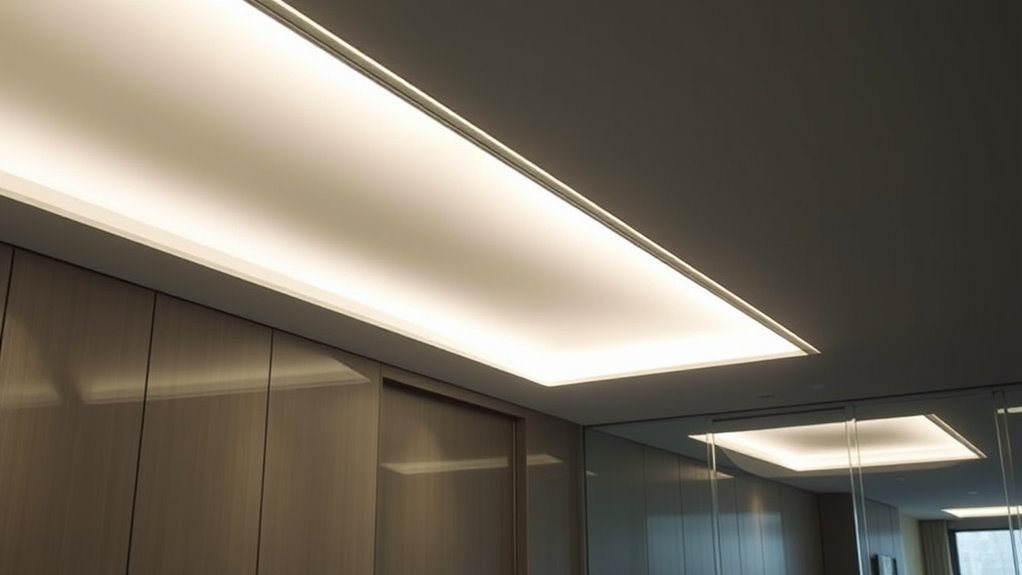To keep your operations discreet, seal all gaps around windows and doors with weatherstripping or caulking, and use blackout curtains to block interior glow. Opt for directional, shielded, or dimmable lighting and position fixtures carefully to contain light inside. Combining these measures reduces leaks, making your space less visible and more secure. Implementing proper lighting controls and strategic placement guarantees you stay under the radar; discover more effective tips if you continue exploring.
Key Takeaways
- Seal gaps around windows and doors with weatherstripping and caulking to prevent light leakage.
- Use blackout curtains and window films to contain interior light and block external glow.
- Choose directional or shielded lighting fixtures to minimize light dispersion outside the space.
- Position lights close to walls or in corners, avoiding placement near windows or open areas.
- Incorporate dimmable and smart lighting controls to adjust brightness and reduce unintended glow.

When you’re trying to keep a low profile, even a small glow can give you away. Light leakage, the unwanted escape of light from your space, can easily betray your presence, especially if you’re aiming to remain discreet. Managing this glow isn’t just about aesthetics; it’s a matter of privacy concerns and maintaining energy efficiency. If your goal is to avoid revealing your location or activity, controlling light leaks becomes essential.
Even a tiny glow can reveal your location—control light leaks to protect privacy and stay discreet.
First, consider the sources of light leakage. Gaps around windows, poorly sealed doors, or thin curtains can all allow light to escape. Even tiny cracks can create noticeable glows from a distance. To combat this, you should invest in proper sealing solutions—weatherstripping around doors, caulking for cracks, and blackout curtains. These measures not only prevent light from escaping but also boost your privacy by reducing outsiders’ visibility into your space. When you block unwanted light, you’re also conserving energy because less light leaks out, meaning your lighting systems don’t have to work as hard to achieve the desired brightness inside. This enhances energy efficiency, saving you money in the long run and reducing your carbon footprint.
Another key step is selecting appropriate lighting fixtures. Opt for directional or shielded lights that focus illumination downward or inward, preventing light from dispersing outward. Use dimmable bulbs and control systems to fine-tune brightness levels based on your needs. Lowering light output not only minimizes glow but also cuts down on energy consumption, aligning with your goal of energy efficiency. When you control when and how much light is emitted, you prevent accidental leaks during late hours or when privacy is most critical.
Furthermore, consider the placement of your lights. Position fixtures closer to the interior walls or in corners to contain the light within your space. Avoid placing bright lights near windows or open areas where light can spill outside. You might also look into window treatments designed specifically for light control—like blackout shades or reflective films—that prevent both light from escaping and outsiders from peering in. These solutions help maintain your privacy and keep your lighting discreet, which is especially important if you’re concerned about security or unwanted observation. Incorporating light control technology can further optimize your lighting setup for minimal leakage while maintaining adequate illumination.
In essence, controlling light leakage isn’t just about avoiding visible glow. It’s about safeguarding your privacy, conserving energy, and maintaining a low profile. By sealing leaks, choosing the right fixtures, and smart placement, you ensure that your space remains discreet while also being more energy-efficient. With these strategies, you’ll stay under the radar without sacrificing comfort or security.
Frequently Asked Questions
How Does Light Leakage Impact Energy Efficiency?
Light leakage reduces energy efficiency because it causes excess light to escape, which can lead to increased energy use for lighting. When you control light absorption, you prevent unnecessary energy loss, and proper thermal insulation helps maintain temperature, reducing the need for additional heating or cooling. By minimizing light leakage, you guarantee more efficient use of energy, saving costs and reducing environmental impact.
What Materials Best Prevent Light Spill in Sensitive Areas?
For preventing light spill in sensitive spaces, opt for materials with durable design and low surface reflectivity. You’ll want options like matte finishes or specialized blackout fabrics that absorb light rather than reflect it. These materials not only diminish glare but also resist wear and tear, ensuring consistent control. By choosing the right durable, low-reflectivity materials, you keep areas clandestine, controlling glow and maintaining a covert, calm environment.
Can Light Control Techniques Improve Privacy in Open Spaces?
You can definitely improve privacy in open spaces using light control techniques. By limiting light trespass, you prevent unwanted glow from illuminating private areas, enhancing residential privacy. Installing directional lighting, using shields, and choosing appropriate fixtures help keep light confined where it’s needed. These methods make certain your outdoor spaces stay private at night without sacrificing safety or visibility, making your environment more secure and comfortable.
Are There Legal Regulations Regarding Light Pollution?
You should be aware that legal standards regarding light pollution exist in many regions. These regulations aim to limit excessive outdoor lighting and protect the environment. Policy enforcement varies but often includes fines or restrictions for non-compliance. It’s important for you to stay informed about local laws to guarantee your lighting practices align with legal requirements and contribute to reducing light pollution effectively.
How Does Light Leakage Affect Wildlife and Ecosystems?
Light leakage can considerably impact wildlife and ecosystems by causing wildlife disturbance and ecosystem disruption. When artificial light spills into natural habitats, animals may become disoriented, alter their behaviors, or abandon nests. Nocturnal species especially suffer, disrupting food chains and breeding patterns. You should control light leakage to protect these delicate environments, ensuring ecosystems remain balanced and wildlife can thrive without unnecessary human interference.
Conclusion
By mastering light leakage, you guarantee your glow stays discreet, much like a spy slipping through shadows unseen. Keep your illumination controlled, and you’ll stay under the radar, avoiding unwanted attention. Remember, even in a world of neon-lit streets and blinking billboards, subtlety is your best ally. So, tighten those shutters and dim your glow—think of it as hiding your secret behind the velvet curtain of the roaring twenties, where silence often spoke louder than words.











